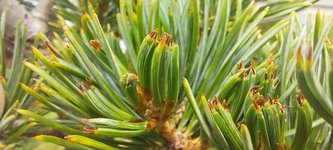Japonicus
Imperial Masterpiece
I have 3 main points of interest/concern with spider mites this year.
History
Following an abnormally warm, and drought snow this past Winter
I have an infestation this year. + May was unusually dry too.
I thought the slow production of new grow tips on my cascade was due
to being repotted last year. Besides, this particular procumbens has in the past
been pretty slow the year following a repot, so I didn’t think too much about it
as I was focused on treating my pines for needle cast, which treatment time coincided
with when the mites were multiplying.
When I noticed the color was off, the infestation was well under way.
I grabbed my sprayer with Malathion in it that had sat all Winter in an out building
left over from last year. Bad mistake. This put a 2nd round of control out another week.
2nd round I used Insecticidal soap with decent results but not good enough.
Now I’m out of the safe soap, and purchased Bayer insect, disease and mite control.
I’m not as impressed with the mite control, as I had been in the past with Malathion
and insecticidal soap. I figured it was time to add an additional rotation to the game.
Yes I am hosing off foliage a couple times a week.
Points of concern:
1. Bringing a tree indoors to work on…
I believe all my junipers have mites, but not all are infested, still, with mites.
Any mites that drop indoors can attack other indoor plants.
I only have 2 house plants in a far bathroom, but will the mites multiply in the house
without other plants to feed on? If they can, what should I do having already brought
a couple of trees through the house and into the attached sunroom where I like to
work, out of the Sun, and to protect recent repots during storms. I usually have to
set the pot down somewhere in the house to open doors.
2. Hosing off…
Great way to help with early caught control, but can the stream be too hard and damage shoots
flexing them in a way that’s overworking them? Should I remove all plants from the porch where displayed
and treat the entire porch too? Obviously, I’m still having issues after 4 treatments.
3. Thinning…
If I don’t thin it is more difficult to control, due to dense foliage.
More foliage provides a buffer to life? I mean if there’s less foliage, the faster it could spiral down right?
Less foliage will disappear faster than thicker pads that need thinning, yet I feel like I should thin
to get best coverage of control and more kill…
History
Following an abnormally warm, and drought snow this past Winter
I have an infestation this year. + May was unusually dry too.
I thought the slow production of new grow tips on my cascade was due
to being repotted last year. Besides, this particular procumbens has in the past
been pretty slow the year following a repot, so I didn’t think too much about it
as I was focused on treating my pines for needle cast, which treatment time coincided
with when the mites were multiplying.
When I noticed the color was off, the infestation was well under way.
I grabbed my sprayer with Malathion in it that had sat all Winter in an out building
left over from last year. Bad mistake. This put a 2nd round of control out another week.
2nd round I used Insecticidal soap with decent results but not good enough.
Now I’m out of the safe soap, and purchased Bayer insect, disease and mite control.
I’m not as impressed with the mite control, as I had been in the past with Malathion
and insecticidal soap. I figured it was time to add an additional rotation to the game.
Yes I am hosing off foliage a couple times a week.
Points of concern:
1. Bringing a tree indoors to work on…
I believe all my junipers have mites, but not all are infested, still, with mites.
Any mites that drop indoors can attack other indoor plants.
I only have 2 house plants in a far bathroom, but will the mites multiply in the house
without other plants to feed on? If they can, what should I do having already brought
a couple of trees through the house and into the attached sunroom where I like to
work, out of the Sun, and to protect recent repots during storms. I usually have to
set the pot down somewhere in the house to open doors.
2. Hosing off…
Great way to help with early caught control, but can the stream be too hard and damage shoots
flexing them in a way that’s overworking them? Should I remove all plants from the porch where displayed
and treat the entire porch too? Obviously, I’m still having issues after 4 treatments.
3. Thinning…
If I don’t thin it is more difficult to control, due to dense foliage.
More foliage provides a buffer to life? I mean if there’s less foliage, the faster it could spiral down right?
Less foliage will disappear faster than thicker pads that need thinning, yet I feel like I should thin
to get best coverage of control and more kill…









